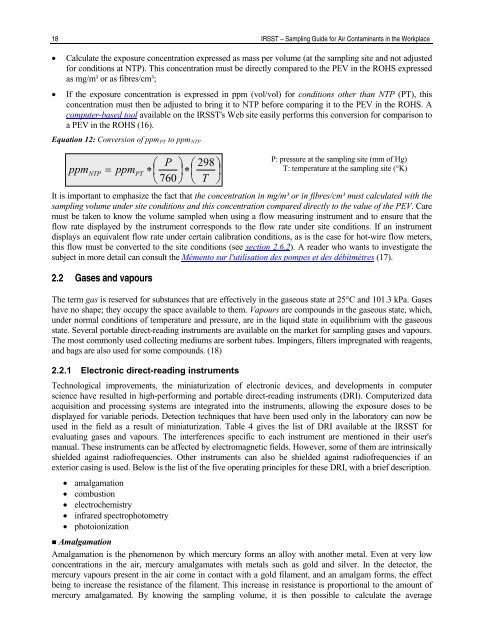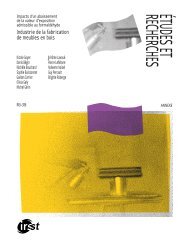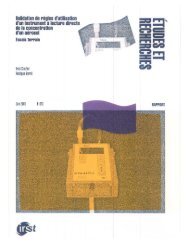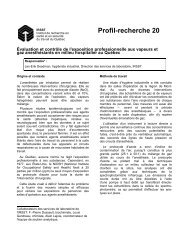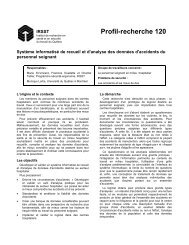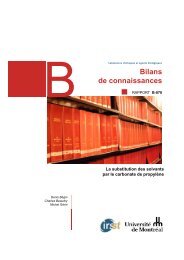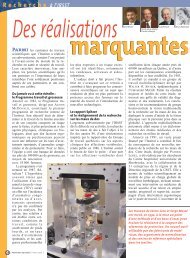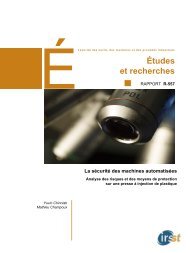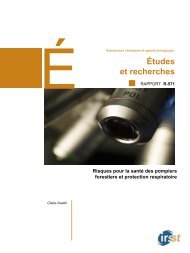Sampling Guide for Air Contaminants in the Workplace - Irsst
Sampling Guide for Air Contaminants in the Workplace - Irsst
Sampling Guide for Air Contaminants in the Workplace - Irsst
Create successful ePaper yourself
Turn your PDF publications into a flip-book with our unique Google optimized e-Paper software.
18 IRSST – <strong>Sampl<strong>in</strong>g</strong> <strong>Guide</strong> <strong>for</strong> <strong>Air</strong> <strong>Contam<strong>in</strong>ants</strong> <strong>in</strong> <strong>the</strong> <strong>Workplace</strong><br />
• Calculate <strong>the</strong> exposure concentration expressed as mass per volume (at <strong>the</strong> sampl<strong>in</strong>g site and not adjusted<br />
<strong>for</strong> conditions at NTP). This concentration must be directly compared to <strong>the</strong> PEV <strong>in</strong> <strong>the</strong> ROHS expressed<br />
as mg/m³ or as fibres/cm³;<br />
• If <strong>the</strong> exposure concentration is expressed <strong>in</strong> ppm (vol/vol) <strong>for</strong> conditions o<strong>the</strong>r than NTP (PT), this<br />
concentration must <strong>the</strong>n be adjusted to br<strong>in</strong>g it to NTP be<strong>for</strong>e compar<strong>in</strong>g it to <strong>the</strong> PEV <strong>in</strong> <strong>the</strong> ROHS. A<br />
computer-based tool available on <strong>the</strong> IRSST's Web site easily per<strong>for</strong>ms this conversion <strong>for</strong> comparison to<br />
a PEV <strong>in</strong> <strong>the</strong> ROHS (16).<br />
Equation 12: Conversion of ppm PT to ppm NTP<br />
ppm<br />
NTP<br />
=<br />
ppm<br />
PT<br />
P: pressure at <strong>the</strong> sampl<strong>in</strong>g site (mm of Hg)<br />
T: temperature at <strong>the</strong> sampl<strong>in</strong>g site (°K)<br />
It is important to emphasize <strong>the</strong> fact that <strong>the</strong> concentration <strong>in</strong> mg/m³ or <strong>in</strong> fibres/cm³ must calculated with <strong>the</strong><br />
sampl<strong>in</strong>g volume under site conditions and this concentration compared directly to <strong>the</strong> value of <strong>the</strong> PEV. Care<br />
must be taken to know <strong>the</strong> volume sampled when us<strong>in</strong>g a flow measur<strong>in</strong>g <strong>in</strong>strument and to ensure that <strong>the</strong><br />
flow rate displayed by <strong>the</strong> <strong>in</strong>strument corresponds to <strong>the</strong> flow rate under site conditions. If an <strong>in</strong>strument<br />
displays an equivalent flow rate under certa<strong>in</strong> calibration conditions, as is <strong>the</strong> case <strong>for</strong> hot-wire flow meters,<br />
this flow must be converted to <strong>the</strong> site conditions (see section 2.6.2). A reader who wants to <strong>in</strong>vestigate <strong>the</strong><br />
subject <strong>in</strong> more detail can consult <strong>the</strong> Mémento sur l'utilisation des pompes et des débitmètres (17).<br />
2.2 Gases and vapours<br />
The term gas is reserved <strong>for</strong> substances that are effectively <strong>in</strong> <strong>the</strong> gaseous state at 25°C and 101.3 kPa. Gases<br />
have no shape; <strong>the</strong>y occupy <strong>the</strong> space available to <strong>the</strong>m. Vapours are compounds <strong>in</strong> <strong>the</strong> gaseous state, which,<br />
under normal conditions of temperature and pressure, are <strong>in</strong> <strong>the</strong> liquid state <strong>in</strong> equilibrium with <strong>the</strong> gaseous<br />
state. Several portable direct-read<strong>in</strong>g <strong>in</strong>struments are available on <strong>the</strong> market <strong>for</strong> sampl<strong>in</strong>g gases and vapours.<br />
The most commonly used collect<strong>in</strong>g mediums are sorbent tubes. Imp<strong>in</strong>gers, filters impregnated with reagents,<br />
and bags are also used <strong>for</strong> some compounds. (18)<br />
2.2.1 Electronic direct-read<strong>in</strong>g <strong>in</strong>struments<br />
Technological improvements, <strong>the</strong> m<strong>in</strong>iaturization of electronic devices, and developments <strong>in</strong> computer<br />
science have resulted <strong>in</strong> high-per<strong>for</strong>m<strong>in</strong>g and portable direct-read<strong>in</strong>g <strong>in</strong>struments (DRI). Computerized data<br />
acquisition and process<strong>in</strong>g systems are <strong>in</strong>tegrated <strong>in</strong>to <strong>the</strong> <strong>in</strong>struments, allow<strong>in</strong>g <strong>the</strong> exposure doses to be<br />
displayed <strong>for</strong> variable periods. Detection techniques that have been used only <strong>in</strong> <strong>the</strong> laboratory can now be<br />
used <strong>in</strong> <strong>the</strong> field as a result of m<strong>in</strong>iaturization. Table 4 gives <strong>the</strong> list of DRI available at <strong>the</strong> IRSST <strong>for</strong><br />
evaluat<strong>in</strong>g gases and vapours. The <strong>in</strong>terferences specific to each <strong>in</strong>strument are mentioned <strong>in</strong> <strong>the</strong>ir user's<br />
manual. These <strong>in</strong>struments can be affected by electromagnetic fields. However, some of <strong>the</strong>m are <strong>in</strong>tr<strong>in</strong>sically<br />
shielded aga<strong>in</strong>st radiofrequencies. O<strong>the</strong>r <strong>in</strong>struments can also be shielded aga<strong>in</strong>st radiofrequencies if an<br />
exterior cas<strong>in</strong>g is used. Below is <strong>the</strong> list of <strong>the</strong> five operat<strong>in</strong>g pr<strong>in</strong>ciples <strong>for</strong> <strong>the</strong>se DRI, with a brief description.<br />
• amalgamation<br />
• combustion<br />
• electrochemistry<br />
• <strong>in</strong>frared spectrophotometry<br />
• photoionization<br />
⎛ P ⎞ ⎛ 298 ⎞<br />
∗⎜<br />
⎟∗⎜<br />
⎟<br />
⎝ 760 ⎠ ⎝ T ⎠<br />
• Amalgamation<br />
Amalgamation is <strong>the</strong> phenomenon by which mercury <strong>for</strong>ms an alloy with ano<strong>the</strong>r metal. Even at very low<br />
concentrations <strong>in</strong> <strong>the</strong> air, mercury amalgamates with metals such as gold and silver. In <strong>the</strong> detector, <strong>the</strong><br />
mercury vapours present <strong>in</strong> <strong>the</strong> air come <strong>in</strong> contact with a gold filament, and an amalgam <strong>for</strong>ms, <strong>the</strong> effect<br />
be<strong>in</strong>g to <strong>in</strong>crease <strong>the</strong> resistance of <strong>the</strong> filament. This <strong>in</strong>crease <strong>in</strong> resistance is proportional to <strong>the</strong> amount of<br />
mercury amalgamated. By know<strong>in</strong>g <strong>the</strong> sampl<strong>in</strong>g volume, it is <strong>the</strong>n possible to calculate <strong>the</strong> average


